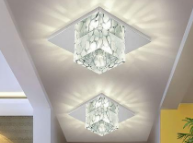
Privacy statement: Your privacy is very important to Us. Our company promises not to disclose your personal information to any external company with out your explicit permission.
Since the advent of the LED semiconductor light-emitting chip technology in the 1960s , as a cold light source with energy saving and no radiation, it has become the development trend of future energy. Through the unremitting efforts of science and technology workers, the color of the light has evolved from the initial red color to the current red, orange, yellow, green, blue and other color lights. However, the LEDs that need to emit white light have only developed in recent years. LED lights are expected to lead the revolution in lighting history after incandescent and fluorescent lights. Experts predict that China from 2005 to 2015, cumulative semiconductor lighting energy-saving 400 billion kWh, for users to save electricity costs of 260 billion yuan, 150 billion yuan output value creating, solving the employment population of one million.
LED lamps have high luminous efficiency and long life, and their luminous efficiency can reach 2.5 times that of fluorescent lamps and 13 times that of incandescent lamps . The luminous efficiency of incandescent lamps is very low, only 5% of the electrical energy is converted into light energy, and 95% of the electrical energy is turned into heat. Fluorescent lamps are better than incandescent lamps, with 20% to 25% of electrical energy converted to light energy, but 75% to 80% of electrical energy is wasted. Therefore, from the perspective of energy utilization efficiency, the utilization efficiency of these two light sources is very low.

1. Service life: The service life of LED exceeds all other light sources. For example, in normal home environment, LED can be used for up to 20 years.
2, energy costs: LED power consumption is very low, LED components, such as OSRAM Opto Semiconductors Golden DRAGONPlus reached luminous efficiency 110lm / W. LED lights only need about 6W to generate the equivalent of 25W incandescent light;
3 , dimming function: LED can be dimmed to further reduce energy consumption;
4 , no mercury: LED does not contain mercury or lead, reducing the cost of disposal;
5 , efficiency: Today's LED efficiency has been about 5 times higher than incandescent lamps , with the continuous advancement of technology, the future efficiency will be 10 times higher. In theory, LED technology can save more than half of the power consumed by artificial lighting.
November 14, 2024
July 03, 2024
July 19, 2023
August 22, 2024
August 22, 2024
October 15, 2024
September 26, 2024
Mail a questo fornitore
November 14, 2024
July 03, 2024
July 19, 2023
August 22, 2024
August 22, 2024
October 15, 2024
September 26, 2024

Privacy statement: Your privacy is very important to Us. Our company promises not to disclose your personal information to any external company with out your explicit permission.

Fill in more information so that we can get in touch with you faster
Privacy statement: Your privacy is very important to Us. Our company promises not to disclose your personal information to any external company with out your explicit permission.